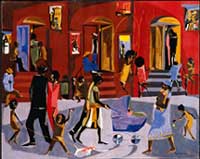|
|
|
Introduction Task Process Resources Evaluation Reflection
Jacob Lawrence found inspiration in the Harlem community
where he was raised. His early work depicts scenes of Harlem life—people,
rooms, facades, sidewalks, streets, and storefronts—in bold colors
and shapes. The most ordinary tasks, events, and routines sparked Lawrence's
imagination. He used what he saw around him every day to document the people,
street scenes, movement, color, sounds, and spirit of the community. In
this image, Lawrence used repetition, shadows, and patterns to create the
rhythm of an urban neighborhood, vibrant with activity.
Back to the Beginning
In this webquest you will:
- Examine how Jacob Lawrence depicted a neighborhood scene.
- Explore how artists have represented their neighborhoods and communities.
- Collaborate in small groups to research and create a written and visual
sample of your neighborhood.
- Present and discuss your neighborhood views with the class.
Back to the Beginning
|
|
 |
Brownstones,
1958
Egg tempera on hardboard
31 1/2 x 37 1/4 in. (80 x 94.9 cm)
Collection of Clark Atlanta University Art Galleries; gift of Chauncey
and Catherine Waddell
© Clark Atlanta University Art Galleries Artwork © Gwendolyn Knight Lawrence, courtesy of the Jacob and Gwendolyn
Lawrence Foundation |
|
| |
|
- Look at Jacob Lawrence's painting,
 Brownstones.
Move your mouse over the painting and find questions to discuss with
your classmates. Brownstones.
Move your mouse over the painting and find questions to discuss with
your classmates.
- Read the information about Jacob Lawrence's painting Brownstones.
- Go to
 http://www.jacoblawrence.org/art04.html
select the medium painting. In the Title box type in "Harlem." Click
on SUBMIT. http://www.jacoblawrence.org/art04.html
select the medium painting. In the Title box type in "Harlem." Click
on SUBMIT.
Look at a selection of paintings where Jacob Lawrence has portrayed
Harlem neighborhood scenes.
- Use the web resources below to explore how artists have represented
neighborhoods and communities in public murals. Consider how these artists
have represented elements of their neighborhood and community. What
else have they included?
- Divide into small groups and do some research about your neighborhood.
How do you define your neighborhood?
Does it have boundaries?
Where does it begin and end?
- Draw a street map of the neighborhood around your school with a key
of symbols that represent important neighborhood sites.
- Visit your local historical society or library. Research and find
photographs of how the neighborhood looked 25-100 years ago.
- Research stories that have been told about the neighborhood and the
people who live there. Use local newspapers, books, and/or interview
people. Rewrite one or more stories in your own words.
- Which views would you select to create a sampling of your neighborhood:
Buildings? People? Streets? Stores? Styles? Music? What else would be
included?
Research and create a sample view of your neighborhood on paper, on
the  computer,
or as a webpage, using images and text. If you use a computer, you could
also include sound and video. computer,
or as a webpage, using images and text. If you use a computer, you could
also include sound and video.
Spend time taking notes, making drawings, and compiling data on what
you see. Take photographs or make a video. Use the following questions
as a guide.
What is your most ordinary view of your neighborhood?
What is your most surprising view?
What evidence of different cultures do you see in your neighborhood?
What kinds of work do you see people doing in your neighborhood?
How do people use the neighborhood’s spaces?
What would you like people to know about your neighborhood?
What would you be able to learn as a visitor or tourist?
Record the sounds of your neighborhood. For example, cars, horns, voices,
sirens, car alarms, animals, footsteps.
- When you have gathered your information, discuss and summarize your
observations with your group. Use images--drawings, photos, video--text,
your map, and the stories that people have told you to make your own
multi-media sampling of your neighborhood. If you recorded sounds, incorporate
them into your multi-media presentation.
- Present and discuss your neighborhood views with the class.
Which views did you select? Why?
What did you learn about how your neighborhood is used?
What does the space you selected tell you about the neighborhood?
Was there anything you hadn’t noticed before?
Back to the Beginning
Philadelphia murals.
 http://pobox.upenn.edu/~davidtoc/murals/neighborhoods.html http://pobox.upenn.edu/~davidtoc/murals/neighborhoods.html
Long Beach.
 http://www.ci.long-beach.ca.us/community/murals/index.htm http://www.ci.long-beach.ca.us/community/murals/index.htm
A selection of murals.
 http://muralart.org/gal.htm http://muralart.org/gal.htm
California murals.
 http://www.muralart.com/california.html http://www.muralart.com/california.html
Los Angeles.
 http://www.usc.edu/isd/archives/la/pubart/LA_murals/USC/ http://www.usc.edu/isd/archives/la/pubart/LA_murals/USC/
Scroll down to see a selection of Chicago murals by children.
 http://www.yollocalli.org/visual_murals.html http://www.yollocalli.org/visual_murals.html
Look for Jacob Lawrence’s New York in Transit mural at the Times
Square subway station.
 http://www.mta.nyc.ny.us/mta/aft/tmp896737009.htm http://www.mta.nyc.ny.us/mta/aft/tmp896737009.htm
Back to the Beginning
You will be evaluated on your visual representation of your neighborhood
as well as the creative story that you write. Your teacher may also choose
to create rubrics for evaluation.
- How well thought out is the design of your neighborhood? Did you use
a sufficient number of resources in order to portray it accurately?
Did you use creative symbols and motifs to represent important neighborhood
sites?
- Does the viewer or reader get a sense of the history and kind of people
found in your neighborhood either from your visual representation or
from your story?
- Is your story interesting to read, and does it represent creativity
and originality while also containing factual and historical information?
Does it contain multiple viewpoints and perspectives about how others
feel about your neighborhood?
 Learning
Standards Addressed Learning
Standards Addressed
Back to the Beginning
Use your neighborhood samplings and images to write a proposal for a neighborhood
mural at your school, or at a public site in the area.
Or
Design a tour of your neighborhood that includes:
The oldest building
The newest building
The most important building
At least ten additional sites that are indicated on your map.
Take your peers on a tour of the neighborhood.
Back to the Beginning |
|









